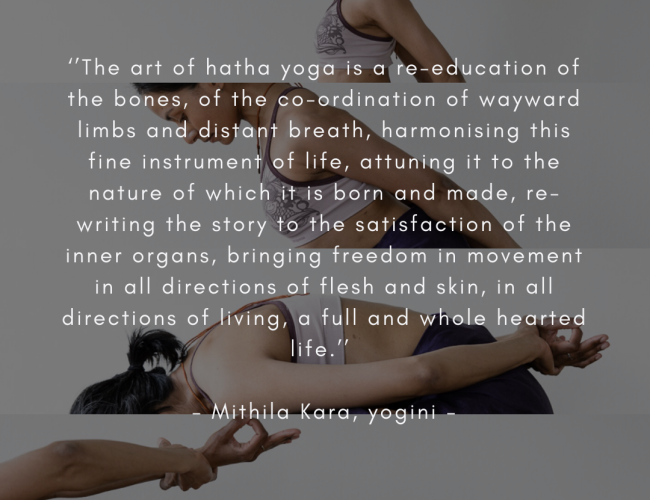
Hatha Yoga - what are you?
Publicerad 26 february, 2021
Hatha Yoga
The Hatha Yogic Practices are part of a much larger network of Yoga and Yogic practices.
See blog post on: Who is Yoga?
Simply defined Hatha Yoga refers to a group of Yogic Practices that utilises the Body-Mind balance and connection as a path to spiritual development and self-realisation. The Sanskrit ‘hatha’ translates to force or effort or wilfulness/exertion to imply the physical energy aspect of the name given to this branch of yoga. It also translates to the Yin/Yang, the balance of masculine and feminine energies, the harmonisation of the human though body, breath and mind. Under this definition many yogic practices could be fully or partially Hatha Yogic Practices.
Below is my own summary on the subject of Hatha Yoga.

What is then Hatha Yoga?
Hatha Yoga as a preparation for Advanced Yogic Practices
The Hatha Yogic Practices refer to practices that work with and through the subtle energy channels of the physical body as a path to Self-Realisation (Yoga). The Hatha Yogic Practices are in and of themselves both the preparation for and the advanced practices of Yoga, sometimes categorised as Raja Yoga, here meaning advanced seated breath and meditation practices.
The Raja Yogic path is often described as the 8 Limbs of Patanjali from the Yoga Sutras
(a scripture dating perhaps from 2nd or 3rd Century).
This Ashtanga Path of sage Patanjali shows us rules, practices and observances…
- for behaviour and moral education and lifestyle (yamas and niyamas)
- for posture practice referencing just the advanced seated postures held for a long time (asana)
- for subtle energy mastery of Prana through breath practices (pranayama in seated posture)
- to be able to withdraw senses from outwards to inwards (pratyahara)
- to develop concentration and absorption into states of meditation (dharana and dhyana)
…that lead to the ultimate state of
Self-Realisation / Yogic Mastery (Samadhi)
The Sutras have far more and deeper esoteric teachings than the above. The 8 Limbs of Yoga are often referenced in modern yogic studies and in Hatha Yoga Studies.
How do you do Hatha Yoga?
Hatha Yoga Practice Path
The merging of breath and posture (either dynamic or still / held postures), through specific energetic channels of the Bodies is the very art and science of Hatha Yoga.
In my book of yoga, and with the above definition in mind, I consider Hatha Yoga an Advanced Practice of Yoga.
If we look at classic Hatha Yoga Teachings / Scriptures such as the 15th Century scripture by Swami Svatmarama, the Hatha Yoga Pradipika (Light on Hatha Yoga), we get the picture of the path of practice that is recommended in that era and then for some centuries to come. Hatha Yoga begins with purification processes, changes in diet and lifestyle, combined with Posture Practice. After Posture Practice has reached a level of mastery then it is Pranayama practice and Meditation practices of greater dignity and difficulty and other energtic practices of Mudra and Bandha are incorporated.
In Sanskrit terminology it is a process of Shatkarma, Asana, Pranayama, Mudra and Bandha.
All of this is considered preparations for advanced yogic practice, sometimes referenced as Raja Yoga, and ultimately for Self-Realisation. However there are other branches of Yoga such as Kriya Yoga or Tantra Yoga who also utilise similar preparations and the advanced techniques of Hatha Yoga. It is a tree of many branches. Some writings categorise Hatha Yoga as its own branch among the main branches of Yoga. In a future post I will explore ''types of Hatha Yoga'' to give more depth to this description.
Why Hatha Yoga?
There are other important commonly known texts related to Hatha Yoga such as the Gheranda Samhita and Shiva Samhita. I have yet to explore these two texts and I am not an expert on Scriptures so I can only share what I myself have concluded from my studies on the Pradipika and on the Sutras of Patanjali, the Bhagavad Gita and when I have read modern translations of the Hatha Yoga Scripts and other modern texts on Yoga. From this exploration and my own practice experience I define Hatha Yoga as follows.
- Hatha Yoga is engaged in as a preparation for higher levels of meditation. Hatha Yoga Posture practice, whether dynamic (vinyasa) or held (asana) is to be practiced to prepare the subtle energy channels (Nadis) to hold and channel greater and greater amounts of energy in stillness (Pranic, Kundalini, other vital energies).
That is one main message of the Hatha Yoga Teachings that I take with me.
Another main message I take with me is that the:
- Hatha Yoga practice is a subtle energy practice through the physical body of which the preparation of the spine and the seat, for higher levels of Yoga, is the key. Therefore we know that accessing and liberating the spine is central (pun intended!) to the Hatha Yogic Practice.
Breath-Work and PranaYama for the movement of Prana is practiced to prepare the Breath-Body Channels (Physical and Astral) for Advanced Yogic Practices.
- The merging of breath and posture (either dynamic or still / held postures), through specific energetic channels of the Bodies is the very art and science of Hatha Yoga.
- To do all or any of the above Advanced Practices of Hatha Yoga, the preparatory practices need to get our Bodies* in shape for the comfortable seat and the centred spine. As a Hatha Yoga Teacher, this preparation is what I concentrate on in my teachings at YogaMonks. I also recommend practicing breath-work and asana/movement separately based on the above defintions. I will explore this more in future articles.
Making Shapes
Now we know that we are on the first step of preparing for Hatha Yoga, that we are making shapes to prepare our bodies for the energetic alchemy of Asana*.
What happens if you google Hatha Yoga or Asana? You will get about 20 million results and so much of this are images of the shape of Hatha Yoga. Vinyasa Yoga is not far behind with 15 million results. Yet from all the above definitions of HY we know that it cannot only be a shape. If it were only a shape then we would have many multitudes of Self-Realised dancers, gymnasts and acrobats and indeed Hatha yogis.
Clearly we love the shape of Hatha Yoga. And why not? It is beautiful to see the shape of the postures in all the different bodies of people. Practicing the shapes can make us feel strong, agile, powerful and more. Mastering the shapes and movements of Hatha Yoga is no easy job. Spirituality is beautiful and physical and there is much to be enjoyed in Hatha Yoga, as in other sports and athletic fields of training, out of sheer beauty and eloquence of shapes and movements. But let us not stop at the shape.
Modern Hatha Yoga teaching often dives straight into the posture and / or breath practices. There is little preparation of the practitioner prior. We modern yogis no longer necessarily follow the extensive preparations that are recommended for the opening of the subtle energy work that Hatha Yoga provides. I see no problem in old methods changing and adapting to the modern world. Some might practice just for the physical well-being and fitness aspect and some might practice for the spiritual evolution of the soul. With everything in between. I do find that the level of entry of even the shape making of Hatha Yoga, the purely physical aspect of the practice, is in most offerings of Hatha Yoga, too high for most. A beginners practice is not really a beginners practice. Also I find that we might be losing the subtle energy experience aspect of the practice if we focus too much on the physical athleticism of the shapes of hatha yoga. There is a delicious combination, of physical and subtle energy and breath that we do not want to miss out on as Hatha Practitioners! As Hatha Yoga Teachers I believe it is our service to provide the pathway to that experience to the students.
If you ever tried a beginners Hatha Yoga or Vinyasa Yoga and felt it was too hard, do not despair. Everything that I have written above is what makes Hatha Yoga an advanced practice. If we have agility/mobility/flexibility in our body we will easier get into the shapes of the postures, and that gives us a leg up (ha ha ha) in where we begin our journey, but it is not enough and certainly not a pre-requisite to begin a subtle energy exploration of a Hatha Yoga practice. We simply need to prepare wisely and enjoyably and practice authentically from where we are today. For this choosing a teacher and a method and beginning where it is appropriate for you gets you moving forward in your HY practice. Let us not stop at the shape.
We may start at the shape, but let us not stop at it. Let us look beyond the shape to the energetic principles Asana practice invites us to discover. Let us put ourselves in a position where Asana can happen.
** What are the Bodies and What is Asana? Future blog post will cover the subject. Stay tuned.
‘’You cannot do Yoga, Yoga does you” - YM-ism from the YogaMonks Method
With love, Mithila
Would you like to make a donation towards my work?
Thank you!
Comments